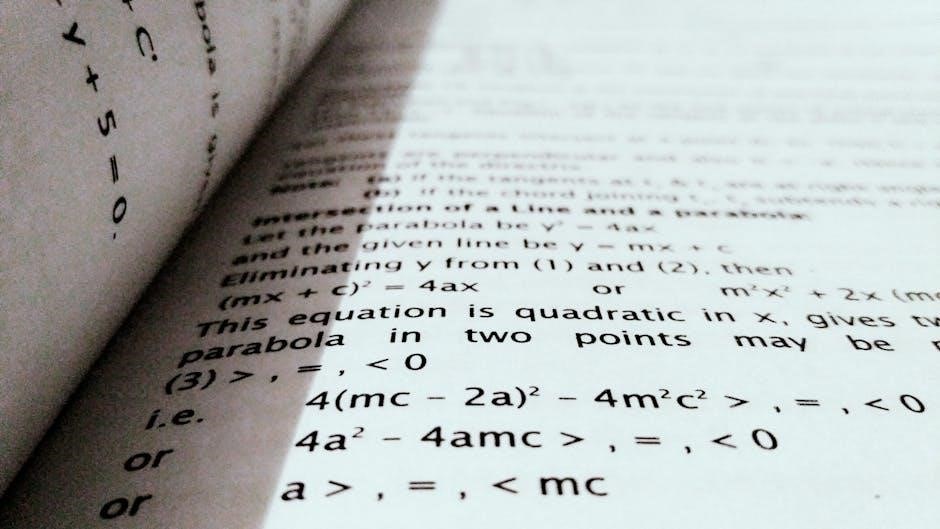Algebra: Structure and Method Book 1 is a renowned textbook co-authored by Mary P. Dolciani, Richard G. Brown, Robert H. Sorgenfrey, and William L. Cole, first published in 1967. It provides a comprehensive introduction to algebraic concepts, emphasizing logical structure and problem-solving techniques. The book is widely recognized for its clear explanations, practical examples, and systematic approach, making it a foundational resource for students and educators alike. Its availability in PDF and hardcover formats ensures accessibility for modern learners.

What is Algebra?
Algebra is a fundamental branch of mathematics that involves the study of symbols, equations, and mathematical structures. It focuses on solving equations and understanding abstract structures such as groups, rings, and fields. Algebraic methods are essential for problem-solving in various fields, including science, engineering, and economics. The term “algebra” originates from the Arabic word “al-jabr,” meaning “reunion of broken parts,” reflecting its role in resolving mathematical problems. Algebraic expressions and equations use variables to represent unknown quantities, allowing for the manipulation and solution of complex relationships. Key concepts include functions, polynomials, and graphing, which provide tools for analyzing patterns and modeling real-world phenomena. Algebra: Structure and Method Book 1 introduces these principles systematically, ensuring a solid foundation for further mathematical exploration.
Importance of Algebra in Modern Mathematics
Algebra holds a central position in modern mathematics, serving as a cornerstone for advanced mathematical disciplines and practical applications. Its principles underpin fields such as calculus, statistics, and geometry, while its problem-solving techniques are indispensable in science, engineering, and economics; Algebraic methods enable the analysis of complex systems, modeling of real-world phenomena, and optimization of processes. In technology, algebra is crucial for algorithm development, data analysis, and artificial intelligence. Beyond academics, algebraic thinking enhances logical reasoning and analytical skills, benefiting everyday problem-solving. Its universal applicability makes it a foundational tool for understanding and navigating the modern world. Algebra: Structure and Method Book 1 emphasizes these essential concepts, preparing learners for both academic and real-world challenges.
Overview of the Book “Algebra: Structure and Method Book 1”
Algebra: Structure and Method Book 1 is a comprehensive textbook designed to introduce students to the fundamentals of algebra; First published in 1967, the book is part of the “Modern School Mathematics” series and has been widely used in educational settings. Authored by Mary P. Dolciani, Richard G. Brown, Robert H. Sorgenfrey, and William L. Cole, it focuses on building a strong foundation in algebraic concepts, structures, and problem-solving methods. The text is structured to promote logical thinking and step-by-step learning, with clear explanations and practical examples. It covers essential topics such as equations, functions, and algebraic expressions, preparing students for advanced mathematics. Available in both hardcover and PDF formats, the book is accessible to learners worldwide. Its systematic approach and emphasis on understanding make it a valuable resource for students and educators alike.

Authors and Contributors
Mary P. Dolciani, Richard G. Brown, Robert H. Sorgenfrey, and William L. Cole are the primary authors of Algebra: Structure and Method Book 1. Additional contributors include Cleo Campbell and Joan MacDonald Piper.
Mary P. Dolciani and Her Contributions
Mary P. Dolciani was a renowned mathematician and educator, best known for her significant contributions to mathematics education. She co-authored Algebra: Structure and Method Book 1, a foundational textbook that emphasized a structured approach to learning algebra. Dolciani’s work focused on making complex mathematical concepts accessible to students through clear explanations and logical progression. Her contributions to the book include the development of its core curriculum, which integrated problem-solving techniques and practical exercises. Dolciani’s innovative teaching methods and commitment to improving mathematics education have left a lasting impact on algebraic instruction. Her collaboration with other authors ensured the book’s comprehensive coverage of key topics, making it a valuable resource for both students and educators. Dolciani’s legacy continues to influence modern mathematics teaching, solidifying her role as a pioneer in algebra education.
Richard G. Brown and His Role in the Book
Richard G. Brown was a key contributor to Algebra: Structure and Method Book 1, bringing his expertise in mathematics education to the project. His role involved refining the book’s content to ensure clarity and effectiveness in teaching algebraic concepts. Brown focused on simplifying complex ideas, making them easier for students to grasp. He emphasized logical reasoning and step-by-step problem-solving, which became a hallmark of the textbook. Brown also contributed to the development of exercises and examples that aligned with real-world applications, enhancing the practical value of the material. His collaborative approach with other authors ensured a cohesive and comprehensive curriculum. Brown’s contributions significantly influenced the book’s accessibility and effectiveness, making it a trusted resource for algebraic studies. His work continues to support educators and students in understanding and mastering algebraic principles.
Robert H. Sorgenfrey’s Influence on the Content
Robert H. Sorgenfrey, a renowned mathematician and educator, played a pivotal role in shaping the content of Algebra: Structure and Method Book 1. His expertise in mathematical structure and rigorous problem-solving techniques significantly influenced the book’s approach to teaching algebra. Sorgenfrey emphasized the importance of logical reasoning and the development of a strong foundation in algebraic principles. He contributed to the organization of key topics, ensuring a smooth progression from basic concepts to more complex ideas. His influence is evident in the book’s focus on properties of real numbers, equations, and functions, which are presented with clarity and precision. Sorgenfrey also advocated for the inclusion of proofs and theorems to reinforce understanding, making the content both comprehensive and intellectually stimulating. His contributions ensured that the book remains a valuable resource for students seeking a deep understanding of algebraic structures and methods.
William L. Cole’s Contributions to the Book

William L. Cole made significant contributions to Algebra: Structure and Method Book 1, bringing his expertise in mathematics education and curriculum development. Cole focused on enhancing the book’s clarity and accessibility, ensuring that complex algebraic concepts were presented in a student-friendly manner. He emphasized the importance of foundational understanding, particularly in areas such as real numbers, functions, and equations. Cole also contributed to the book’s problem-solving strategies, incorporating practical examples and exercises that aligned with classroom teaching methods. His attention to detail and commitment to accuracy ensured the content was both rigorous and engaging. Additionally, Cole collaborated with other authors to integrate visual aids and diagrams, making abstract concepts more tangible for learners. His contributions reflect a deep understanding of how students learn algebra, making him a valuable asset to the book’s development and success in educational settings.
Other Contributing Authors and Their Roles
Besides the primary authors, several other contributors played crucial roles in shaping the content and quality of Algebra: Structure and Method Book 1. These individuals brought diverse expertise, ensuring the book’s comprehensive and accessible approach. Some contributors focused on refining problem sets, while others reviewed content for accuracy and clarity. Additional authors specialized in developing visual aids and supplementary materials, enhancing the learning experience. Their collective efforts ensured the book met high educational standards, providing students with a robust foundation in algebra. These contributors’ dedication and specialized skills were instrumental in making the book a trusted resource for both teachers and learners. Their work underscores the collaborative nature of the project, highlighting the importance of teamwork in educational publishing. The inclusion of their contributions further solidified the book’s reputation as a leading algebra textbook.

Content and Structure of the Book
The book is logically structured to build foundational algebra skills progressively. It emphasizes clarity, with chapters organized to ensure comprehensive understanding. Topics range from basic concepts to advanced methods, blending theory with practical applications.

Chapter Breakdown and Key Topics Covered
The book is divided into well-structured chapters, each focusing on specific algebraic concepts. Early chapters introduce fundamental topics such as algebraic expressions, equations, and inequalities. Intermediate chapters explore functions, graphs, and systems of equations, providing a solid foundation for problem-solving. Advanced chapters delve into polynomials, rational expressions, and quadratic equations, with detailed explanations and examples. The content is designed to progressively build students’ skills, ensuring mastery of each concept before moving to the next. Key topics include solving linear and non-linear equations, understanding function properties, and applying algebraic methods to real-world problems. The chapter breakdown ensures a logical flow, making it easier for learners to grasp complex ideas step by step. This structured approach helps students develop a deep understanding of algebraic principles and their practical applications.

Learning Approach and Methodology
The book employs a systematic and engaging learning approach, designed to foster a deep understanding of algebraic concepts. It follows a clear, step-by-step methodology, starting with basic principles and progressively building complexity. Each chapter includes detailed explanations, annotated examples, and guided practice problems to reinforce learning. The text emphasizes critical thinking and problem-solving skills, encouraging students to approach algebra as a logical and analytical tool. Visual aids, such as graphs and diagrams, are used to illustrate key ideas, making abstract concepts more accessible. The methodology also incorporates real-world applications, helping students connect algebra to practical scenarios. This balanced approach ensures that learners not only master procedural skills but also develop the ability to reason mathematically. The book’s structured and supportive format makes it suitable for both classroom instruction and independent study, catering to diverse learning styles and needs.
Problem Solving Techniques Emphasized
The book places a strong emphasis on developing robust problem-solving techniques, equipping students with tools to tackle algebraic challenges effectively. It introduces methods such as identifying patterns, using substitution, and applying properties of equality and inequality. Students are encouraged to break down complex problems into manageable steps, fostering logical reasoning and systematic thinking. The text also highlights the importance of verifying solutions through reverse operations and substitution, ensuring a deep understanding of the underlying principles. Real-world applications are woven throughout the chapters, helping students see the practical relevance of algebra. By emphasizing these techniques, the book prepares learners to approach problems with confidence and precision, whether in academic or real-life scenarios. The focus on methodology ensures that students develop a strong foundation for advanced mathematical studies.
Examples and Exercises for Practical Learning
The book is renowned for its extensive use of examples and exercises, designed to reinforce theoretical concepts through practical application. Each chapter begins with worked-out examples that illustrate key ideas, followed by a wide range of exercises that cater to different learning levels. These exercises include routine drills, application-based problems, and challenging questions that encourage critical thinking. The examples are carefully structured to progress from basic algebraic manipulations to more complex scenarios, such as solving linear equations, graphing functions, and simplifying expressions. Additionally, the text incorporates real-world applications to help students connect abstract concepts to practical situations. Supplementary materials, including the teacher’s edition, provide even more exercises and practice sets for comprehensive learning. This emphasis on hands-on practice ensures that students master algebraic principles and develop the skills needed for advanced studies in mathematics.

Significance and Impact
Algebra: Structure and Method Book 1 has profoundly influenced mathematics education, offering a clear, structured approach to learning algebra. Its logical progression and practical examples have made it a cornerstone in schools worldwide.
Educational Impact of the Book
The educational impact of Algebra: Structure and Method Book 1 has been significant, shaping the way algebra is taught and learned. Its structured approach has helped students build a strong foundation in algebraic concepts, enabling better problem-solving skills. The book’s clarity and logical progression have made it a favorite among educators, who appreciate its ability to engage students of varying skill levels. Many schools have adopted it as a core textbook, and its influence is evident in improved student performance in mathematics. The availability of the PDF version has further expanded its reach, making high-quality algebra education accessible to a global audience. This widespread adoption underscores its role as a transformative resource in modern mathematics education.
Popularity and Reviews of “Algebra: Structure and Method Book 1”
Algebra: Structure and Method Book 1 has garnered widespread acclaim for its comprehensive and accessible approach to teaching algebra. Students and educators alike have praised the book for its clear explanations, logical structure, and engaging examples. Many reviewers highlight its ability to simplify complex concepts, making it an invaluable resource for learners at all levels. The PDF version has further boosted its popularity, offering convenience and accessibility to a broader audience. Overall, the book is widely regarded as a trusted and effective tool for mastering algebraic principles. Its positive reception underscores its enduring relevance in mathematics education.
The Book’s Place in Modern Curriculum
Algebra: Structure and Method Book 1 holds a prominent position in modern educational curricula due to its structured approach and emphasis on foundational algebraic concepts. Its logical progression and detailed explanations make it a favored choice for educators seeking to align their teaching with contemporary learning standards. The book’s focus on developing problem-solving skills and critical thinking resonates with current educational goals that prioritize deeper understanding over rote learning. Additionally, its availability in PDF format enhances its accessibility, catering to the growing demand for digital learning resources. While it remains a cornerstone in many algebra courses, some educators have expressed interest in integrating more modern, interactive tools to complement its traditional methodology. Nonetheless, its enduring relevance ensures its continued use in shaping mathematical proficiency for students worldwide.

Additional Resources and Supplements
Supplementary materials include online resources, video tutorials, and interactive tools to enhance learning. Study guides and practice workbooks are also available, along with digital platforms offering additional support for students.

Available PDF Versions and Digital Access
Digital versions of Algebra: Structure and Method Book 1 are widely available, offering students and educators convenient access to the material. PDF formats ensure portability and ease of use across devices, making it ideal for both classroom and self-study environments. Many educational platforms provide downloadable versions, often accompanied by interactive features such as searchable content, bookmarks, and highlighting options. Additionally, some institutions offer digital access through their libraries or learning management systems. These resources are particularly beneficial for students who prefer or require digital learning tools. When accessing PDF versions, ensure they are sourced from reputable websites or authorized distributors to maintain quality and accuracy. Digital access also supports environmentally friendly learning practices by reducing the need for physical copies. Overall, the availability of PDF versions enhances accessibility and flexibility for learners worldwide.
Teacher Edition and Supplementary Materials
The teacher edition of Algebra: Structure and Method Book 1 is designed to support educators in delivering effective instruction. It includes detailed lesson plans, teaching strategies, and answers to all exercises, providing instructors with comprehensive resources to guide their students. Supplementary materials, such as teacher guides and resource manuals, are also available to enhance classroom teaching. These resources often include additional examples, tips for differentiated instruction, and assessments to monitor student progress. For students, supplementary materials like workbooks, online practice sets, and interactive tools are provided to reinforce learning. Many of these resources are available in both print and digital formats, offering flexibility for various teaching and learning styles. The teacher edition and supplementary materials are invaluable for creating a structured and engaging learning environment, ensuring that both teachers and students have the tools needed for success in algebra studies.

Be First to Comment